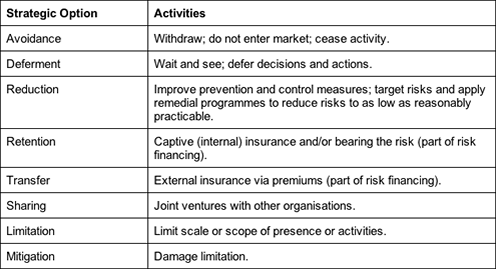Archive for November 4th, 2012
Introductions: Risk Management no comments
Last week I was very excited to take a look at technoethics and found that the more I read, the more I wanted to read about it. This week, reading around the area of risk management, I have found myself in a similar situation. My mind has been buzzing with ideas about how these fields can contribute in a big way to Web science. Nonetheless, I will briefly introduce the area of risk management at this time and share these potential applications in my future posts.
Brief Overview of Risk

Defining Risk
Before talking about managing risks, it is fitting that I define risk. It has been noted that risk is defined differently from one field to the next and there is sometimes contradiction in its definition (Vaughan, 1997). This lack of agreement on definition has been partly attributed to the relatively young age of the field and practitioners adopting definitions of risk from varying fields. However, for the purposes of my adventure in the discipline, I have chosen to define risk as “an event with the ability to impact (inhibit, enhance or cause doubt about) the mission, strategy, projects, routine operations, objectives, core processes, key dependencies and or the delivery of stakeholder expectations.” (Hopkin, 2010, p. 12).
When an organisation employs the Web, it is hoped that it will lead to a favourable outcome (e.g., increased productivity) and not hurt the company (e.g., cause legal troubles) in any way. In many situations within organisations, especially when technology is involved, the result could be uncertain and this constitutes a risk. For example, as the impact of the Web could be different to what is expected, its adoption could be considered as being a control risk.
Types of Risk
There are several ways to classify types of risks and there appears to be no generally accepted classification that is right or wrong. Practitioners often adopt classifications that are appropriate for their circumstances. In addition to the control/uncertainty risks mentioned, texts usually mention two other risks: hazard/pure risks and opportunity/speculative risks. Hazard or pure risks typically refer to things like theft, health and safety risks. Opportunity or speculative risks are usually associated with financial investments, critical business decisions such as moving location or offering a new product, and also, taking or not taking the opportunity.
Not All Risks Are Equal
As you can appreciate, some situations pose a higher degree of risk than others. Situations where there is a high likelihood of a negative outcome occurring or a high probability of loss are usually considered as being riskier than situations at the other end of the spectrum. A good example of this is given by Vaughan (1997). When playing Russian roulette, there is more risk with each bullet loaded into the gun, (until obviously when the barrel is fully loaded – it’ll be certain you’re going to get shot).
Brief Overview of Risk Management

Defining Risk Management
Hubbard (2009) defined risk management as “the identification, assessment, and prioriti[s]ation of risks followed by coordinated and economical application of resources to minimi[s]e, monitor, and control the probability and/or impact of unfortunate events” (p. 10). Simply put, Hubbard believes risk management is “being smart about taking chances.” Having looked at many definitions, one consistent and important characteristic of risk management is that it is a systematic approach to dealing with risk that follows a particular process depending on the risk circumstance.
Some texts (e.g., Scarff, Carty & Charette, 1993) has found it necessary to separate the concepts of ‘management of risk’ and ‘risk management’. The latter refers to the activities of planning, controlling and monitoring, whereas the former includes such activities, as well as those associated with risk analysis.

Dealing with Risk
Risk management aims to eliminate, reduce or control risks and gain enhanced usefulness or benefits from them (Waring & Glendon, 1998). It has been suggested that successful risk management programmes feature a strategy that is:
- proportionate to the level of risk posed;
- aligned with other business activities;
- comprehensive, systematic and structured;
- embedded within business processes;
- dynamic, iterative and responsive to change.
According to Waring and Glendon (1998, p. 9), risk management involves the optimal combination of the following strategic options:

Notes
This Week’s Plan
- Reading more about the methodologies associated with the selected disciplines.
- Prepare a blog post that describes the methodologies adopted by the selected disciplines and compare them.
- Explore the contributions these disciplines could make to each other and Web science.
- Publish a blog post that discusses the potential applications of these disciplines to Web science.
Last & Previous Week’s Plan
Identifying the simplest books to read that will give an easy to understand introduction to the disciplines I picked.Making notes on books read.Prepare a blog post that gives an overview of what I want to work on.Publish a blog post that introduces technoethics.Publish a blog post that introduces risk management.Outline a reading plan for moving forward.
Introductory Readings
Ethics: A Very Short Introduction– Simon BlackburnHandbook fo Research on Technoethics– Rocci Luppicini & Rebecca AdellManaging Risk: Critical Issues for Survival and Success Into the 21st Century– Alan Waring and A. Ian GlendonIntroduction to the Management of Risks– Frances Scarff, Andy Carty and Robert CharetteRisk Management– Emmett J. VaughanThe Failure of Risk Management: Why It’s Broken and How to Fix It– Douglas W. HubbardFundamentals of Risk Management Understanding, Evaluating and Implementing Effective Risk Management– Paul Hopkin
Marketing Management Philosophies – New Economy – Information Bussinesses no comments
Marketing is a social and manager process whereby individuals and groups obtain what they need and want through creating and exchanging products and values with others. There are five alternative concepts under which organisations conduct their activities, the so-called marketing management philosophies: the production, product, selling, marketing and societal concepts. The production concept holds that consumers favour products that are available and highly affordable; management’s task is to improve production efficiency and bring down prices. The product concept holds that consumers favour products that offer the most in quality, performance and innovative features; thus, little promotional effort is required. The selling concept holds that consumers will not buy enough of the organisation’s products unless it undertakes a large-scale selling and promotion effort. The societal marketing concept holds that generating customer satisfaction and long-run societal well-being are the keys to both achieving the company’s goals and fulfilling its responsibilities.
Most successful and well-known companies have adopted the marketing concept, according to which achieving organisational goals depends on determining the needs and wants of target markets and delivering the desired satisfaction more effectively and efficiently than competitors do. Implementing the marketing concept often means more than simply responding to customers’ stated desires and obvious needs. Customer-driven companies research customers to learn about their desires, gather new product and service ideas, and test proposed product improvements.
The explosive growth in connecting technologies has created a New Economy which provides marketers with new ways to learn about and track customers as well as create product and services tailored to meet customer’s needs. Marketers have redefined how they connect with their customers; in contrast with yesterday’s companies that focused on mass markets, today’s companies are selecting their customers more carefully and developing more lasting and direct relationships with them. Web seems to enable customer relationship building as companies can demonstrate the abovementioned marketing concept on their web sites by including features that are important to consumers; online companies have moved from mass marketing to segmented marketing or one-to-one marketing, in which they target carefully chosen individual buyers.
The New Economy revolves around information businesses; information has the advantages of being easy to differentiate, customize, personalise and dispatch at incredible speeds over networks. With rapid advances in connecting technologies companies have grown skilled in gathering information about individual customers and more adept at individualising their products. Marketing companies go to great lengths to learn about and understand their customers’ needs, wants and demands; they build extensive customer databases containing rich information on individual customer preferences and purchases and then they mine these databases to gain insight by which they ‘mass-customise’ their offerings to deliver greater value to individual buyers. Web enables consumers and companies to access and share an unprecedented amount of information with just a few mouse clicks. In order to be competitive in today’s new marketplace, companies should adopt web technologies or risk being left behind.
**************
Armstrong, G. & Kotler, P. (2003) Marketing: An Introduction. New Jersey: Pearson Education Ltd
Drummond, G. & Ensor, J. (2005) Introduction to Marketing Concepts. Oxford: Elsevier Butterworth – Heineman
Kotler, P., Armstrong, G., Saunders, J., Wong, V. (2001) Principles of Marketing. New Jersey: Pearson Education Ltd
Palmer, A. (2012) Introduction to Marketing: Theory and Practice. Oxford University Press
Masterson, R. & Pickton, D. (2010) Marketing: An Introduction. London: SAGE Publication Ltd